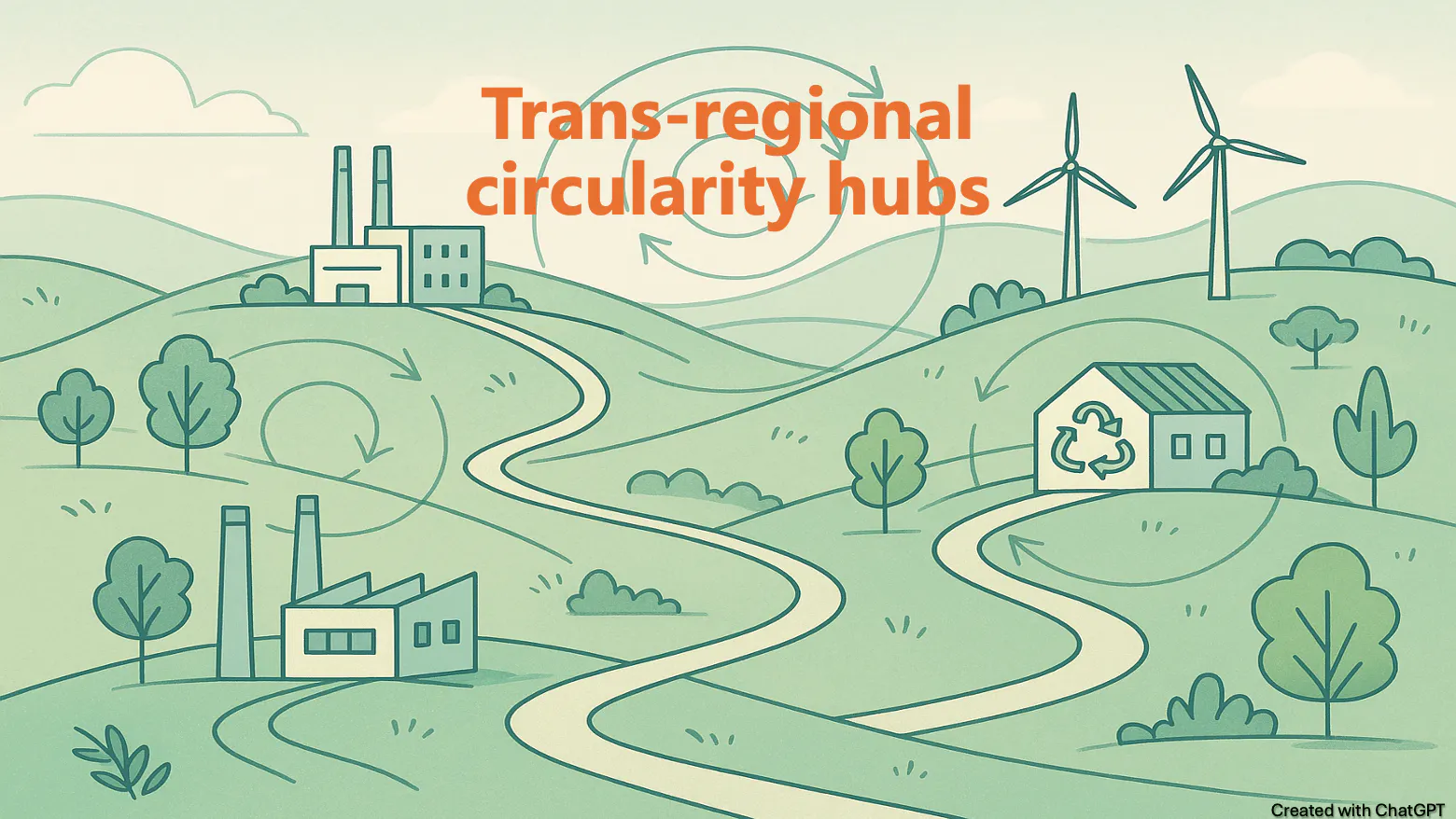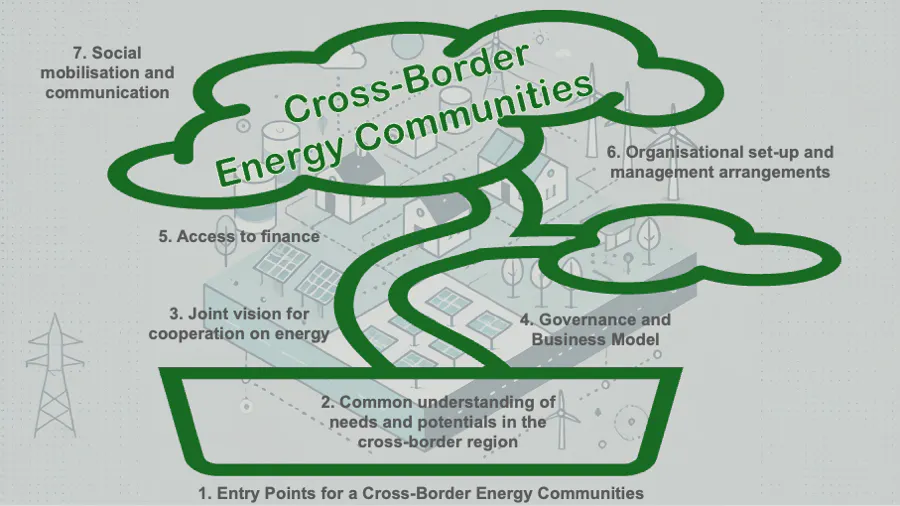Connecting the dots for a greener future: Trans-regional circularity hubs
May 2025

As the EU continues to push for a greener, more resource-efficient economy, new concepts and tools are emerging that reflect both the complexity of this transformation and the need for coordinated action across regions. One such idea that is gaining traction is that of trans-regional circularity hubs, recognising that the challenges and opportunities of the circular economy do not stop at administrative borders and that there is potential in working together across borders. Trans-regional circularity hubs are expected to unlock the potential of circular value chains at scale by connecting industrial, urban and policy actors across regional and national borders. But what exactly are these hubs and how do they fit into the evolving EU policy landscape?
The aim and purpose of trans-regional circularity hubs
The idea of trans-regional circularity hubs has recently come into the spotlight, thanks in part to the Clean Industrial Deal - a strategic initiative under the European Green Deal that aims to align industrial competitiveness with climate neutrality goals. The idea builds on the updated Circular Economy Action Plan (2020) (Opens in a new window), which highlights the importance of systemic change and industrial symbiosis in achieving a climate-neutral, competitive economy by 2050.
For outsiders, it is still not entirely clear what trans-regional circularity hubs could be. The European Commission envisages these hubs in the context of promoting EU-wide cooperation, in particular through groups of Member States and/or industrial actors. This suggests a clear interest in supporting cross-border value chains and shared circular infrastructure across national borders. The EU's role in enabling such hubs lies precisely in its ability to reduce barriers between member states - such as regulatory fragmentation, trade barriers or uneven development. If circularity hubs operated only within a single country, there would be less need for EU-level intervention.
The concept is expected to gain further traction in the forthcoming Circular Economy Act, planned for 2026. This legislative proposal aims to support the circulation of products, waste and secondary raw materials across the EU single market – providing a legal and operational basis for circularity hubs to thrive. In parallel, policy documents on smart specialisation and the EU Industrial Strategy increasingly point to the importance of place-based and cross-border cooperation for industrial decarbonisation and resource efficiency.
At their core, trans-regional circularity hubs can be seen as platforms for collaboration. They can bring together actors from different regions to align their industrial capacities, material flows and innovation systems with circular economy principles. The aim would be to go beyond isolated pilot projects and instead foster long-term cooperation, enabling economies of scale, shared infrastructure and more resilient value chains.
These hubs would not just be about improving recycling rates or waste management. They are about system-level integration; linking production processes, urban infrastructures and innovation ecosystems to close energy, material and data loops. This can mean creating industrial symbioses across regions, building shared logistics for secondary raw materials, or coordinating regional circular innovation strategies.
Crucially, trans-regional hubs might help match supply and demand for secondary resources across larger regions – overcoming the regional mismatches and regulatory fragmentation that often limit circular value chains today.
Why trans-regional cooperation matters
Thinking beyond national borders makes a lot of sense when it comes to promoting circularity. The challenges and opportunities of the circular economy rarely respect administrative boundaries. Many material streams - such as plastics, textiles, construction waste or critical raw materials – cross national borders due to the nature of supply chains, industrial clusters and consumption patterns. Regions may produce certain types of waste but lack the infrastructure or market to process them. Others may have a high demand for secondary materials but struggle to source them locally. Without cross-border coordination, valuable resources risk being lost, under-utilised or subject to inefficient logistics.
In addition, regulatory frameworks, data standards and technological capabilities differ across Member States, creating friction in the development of circular solutions. Trans-regional hubs can help overcome these differences by promoting harmonisation and common practices among the partners involved. They also enable mutual learning, helping less advanced regions to benefit from the expertise of more experienced partners.
From an economic perspective, cross-border cooperation can unlock new business models and investment opportunities that may not be viable at a local or national level. By creating a critical mass of actors, material flows and knowledge, transnational hubs can act as magnets for innovation and funding – supporting the EU's ambition to become a global leader in circular technologies and practices.
Moreover, circularity hubs can contribute to the EU's industrial decarbonisation goals. By facilitating the reuse of materials and reducing dependence on energy-intensive primary production, they support emission reductions and resource efficiency in parallel. This positions them as an important lever for achieving both circular economy and climate neutrality objectives.
In short, thinking across borders is not only logical. It is necessary. A functioning circular economy in the EU requires territorial cooperation, trust building across regions and support mechanisms that enable circular value chains to scale up in a coherent and integrated way.
Although still an emerging concept, there are already several initiatives that provide valuable lessons for the development of trans-regional circularity hubs.
Hubs4Circularity (H4C) (Opens in a new window), a Horizon Europe project, is a prominent example. These hubs are described as socio-technical ecosystems that support industrial and urban symbiosis on a regional scale. The initiative emphasises collaboration between industry, communities and research institutions, with a focus on shared learning and replication.
The IS2H4C (Industrial Symbiosis to Hubs for Circularity) (Opens in a new window) project is another relevant case. It aims to demonstrate circular synergies through technologies such as carbon capture and electrolysis in four regional hubs across Europe. The project focuses on embedding these hubs in their surrounding ecosystems, demonstrating the importance of the local context for successful circular transitions.
At a more policy-driven level, the Circular Cities and Regions Initiative (CCRI) (Opens in a new window) provides tailored support to local and regional authorities implementing circular economy policies. Although not explicitly cross-border, the methods and governance tools of the initiative could be adapted to the trans-regional scale.
Linking to other initiatives and communities
The formation of trans-regional circularity hubs can benefit from the projects mentioned above, but also from a wealth of EU initiatives and networks that could support or align with the development of such hubs.
Interreg programmes, particularly those focused on innovation, green transition and cross-border cooperation, offer both funding and governance experience for building partnerships across regions. Many Interreg projects have already explored circular economy approaches - particularly in border regions where material flows and supply chains often cross national borders. To take just one example, the Interreg Europe Policy Learning Platform (Opens in a new window) addresses circular economy topics ranging from waste prevention to resource efficiency and green public procurement.
Cross-border energy communities are also a source of inspiration (see also our earlier blog post on this (Opens in a new window)). These communities demonstrate how decentralised actors can work together across regions to produce and share renewable energy. Similar governance mechanisms and regulatory adjustments could be adapted to support material and waste flows within circularity hubs.
In addition, the EU's Smart Specialisation Strategies (S3) provide a framework for aligning regional development priorities with innovation and industrial policy. Trans-regional hubs could serve as platforms for inter-regional S3 partnerships focused on circular value chains, leveraging shared strengths and complementing industrial capacities across borders.
Potential benefits and conclusions
Trans-regional circularity hubs could provide an opportunity to move from fragmented efforts to more systemic and scalable circular solutions. By building bridges between regions, sectors and levels of governance, these hubs have the potential to help address several persistent challenges:
Efficiency and resilience: By pooling resources and capacities, regions can better manage material flows, reduce their dependence on primary commodities and increase their economic resilience.
Innovation and learning: Hubs can serve as platforms for experimentation and knowledge transfer, accelerating the uptake of circular business models and technologies.
Cohesion and equity: By engaging multiple regions, including those with different starting points and capacities, circularity hubs can contribute to a more balanced green transition - helping to ensure that no region is left behind.
Scalability: Hubs can help scale up successful local initiatives by connecting them to broader networks and value chains, turning isolated pilots into impactful system innovations.
Challenges remain, of course; particularly around regulatory harmonisation, infrastructure investment and coordination between different levels of government. But the foundations are in place. With the right mix of ambition, support and local ownership, trans-regional circularity hubs could become a cornerstone of Europe's circular and industrial future.
As the policy debate matures and legislative frameworks evolve, now is the time to explore, pilot and connect. Trans-regional circularity hubs may not be the silver bullet, but they are an important piece of the puzzle – a practical way to turn the promise of the circular economy into tangible, collaborative progress across Europe.
In the race for a circular, climate-neutral future, trans-regional circularity hubs might just be Europe’s best-kept secret - waiting to be scaled, connected, and unleashed.
by Kai Böhme
 (Opens in a new window)
(Opens in a new window)


